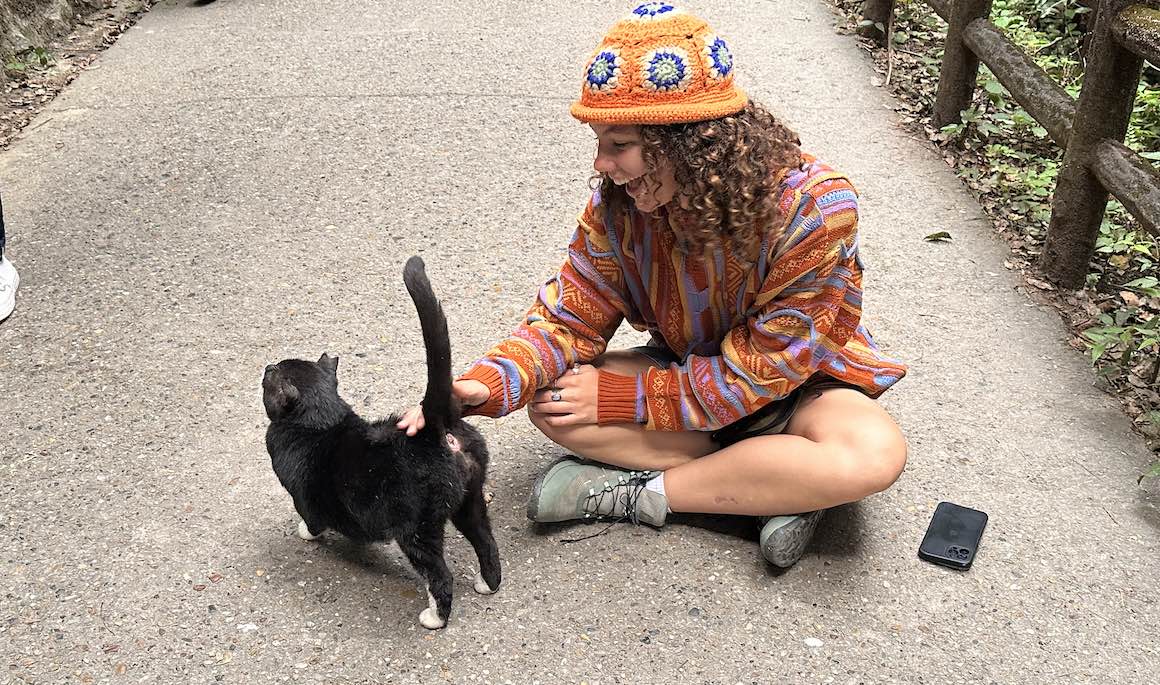Travelling with pets has become increasingly popular in recent years, reflecting the growing trend of pet owners wanting to include their furry companions in their adventures. In fact some estimates suggest that as many as 64% of pet owners have taken a trip with a pet, and American Airlines confirm that they fly over 4 million pets each and every year. Woof!
While it can be an incredibly rewarding experience, it’s essential to recognise that backpacking with a pet requires careful planning and preparation and it can also limit the kind of travelling that you can do – these are all things you need to be fully aware of.
With that in mind, in this kick-ass guide, we’ll delve into the intricacies of preparing for a backpacking trip with your pet to ensure a safe and enjoyable journey for both you and your furry friend.

The Broke Backpacker is supported by you. Clicking through our links may earn us a small affiliate commission, and that's what allows us to keep producing free content 🙂 Learn more.
Travelling With a Pet – An Overview:
As more and more pet owners opt to bring their pets along on their travels, it’s essential to fully understand the dynamics involved in travelling with a pet. While it can undoubtedly add an extra layer of companionship and joy to your journey, it’s not without its challenges.
Let’s get started.
Why Bring Your Pet?
Before even embarking on your backpacking adventure with your pet, it’s crucial to assess whether it’s the right decision for both you and for your furry lil friend. There are definite pros and cons to pet travel. You should consider factors such as your pet’s temperament, health, and comfort with travelling. If you believe your pet is up for the adventure and you’re prepared to meet their needs, then travelling together can be truly and properly fulfilling experience.
However, if your pet is likely to find the experience traumatic or if you’re unable to provide adequate care during your travels, then it may be best to explore alternative arrangements, such as hiring a pet sitter or utilising a reputable kennel or cattery.
When I first started travelling in 2014, I had to re-house my cat. It was a heartbreaking moment, but it had to be done and I gave him to a trusted friend who I knew would take care of him, in a place I knew that Teddy would just love.
Pet Passports

One of the essential considerations when travelling internationally with your pet is ensuring they have the necessary documentation, such as a pet passport. Research the specific requirements for your destination country and ensure your pet meets all the necessary criteria.
Obtaining a pet passport typically involves providing proof of vaccinations (more on this to come) and other health certifications, so be sure to plan well ahead to avoid any last-minute complications.
Note that in the United States, a pet passport is not a formal travel document like it is in some other countries (the EU and the UK for example). However, pet owners travelling internationally with their furry companions still need to ensure that they have the necessary documentation to meet the entry requirements of their destination country.
For most international travel with pets from the US, the primary document required is a health certificate issued by a licensed veterinarian.
Vaccinations
Before embarking on your backpacking trip, ensure your pet is up-to-date on all required travel vaccinations for all of the countries you intend to visit. This is not only essential for their health and well-being but also for complying with the entry requirements of your destination country.
Keep all vaccination certificates and records organised and easily accessible during your travels to facilitate smooth entry at border crossings.
Also bear in mind that while pet illnesses like rabies are relatively rare in the west, they are very, very common in much of the developing world so ask yourself whether you really want to expose Tiny Tybalt to this risk.
Where Are You Going?
Carefully consider the pet-friendliness of your chosen destination, both in terms of entry requirements and the overall experience for your furry companion when you arrive. Some countries may have stricter regulations regarding pet entry, while others may offer a more welcoming environment for pets. This is especially pertinent when it comes to choosing pet friendly accomodation.
Additionally, consider factors such as climate and temperature changes, as extreme conditions can adversely affect your pet’s health and comfort during travel.
Finally, think about how far away your destination is and how your little bundle of furry joy will handle being sat in a cage in the hold of an aeroplane for the duration of the flight. Look at it like this, a 10 hour flight is a long time for a person but it’s a micro eternity for an animal.
Insurance
In addition to securing your own travel insurance, it’s advisable to invest in pet travel insurance to provide financial protection in the event of unexpected veterinary expenses or other pet-related emergencies during your trip. This added layer of security can offer serious peace of mind and ensure that you’re prepared for any unforeseen circumstances that may arise.
Many travel insurance plans focus solely on human travellers, and pet insurance policies often exclude travel coverage. It’s essential to find a provider that offers comprehensive coverage for pets on the go, ensuring protection against a variety of potential issues without breaking the bank. For example,a Lemonade pet policy can help cover the cost of your pet’s vet bills from any vet you like in the U.S., as long as they’re licensed to provide veterinary care in the state they operate in.
Food
Be mindful that the availability and quality of pet food may vary depending on your destination. If your pet has specific dietary requirements or preferences, consider bringing an ample supply of their regular food to ensure they remain well-nourished throughout their travels.
Additionally, be prepared to adapt to local food options if necessary, keeping in mind your pet’s health and dietary needs. Ultimately, travelling is perhaps not for those pets who have developed overtly refined palettes!
Final Thoughts

OK so there we are.
Preparing for a backpacking trip with your pet requires careful planning and consideration of their unique needs and wellbeing. By taking the time to assess your pet’s suitability for travel, ensuring they have the necessary documentation and vaccinations, and making provisions for their health and well-being during your journey, you can create unforgettable memories together.
Remember to prioritise your pet’s comfort and safety at all times, and don’t forget to explore pet travel insurance options to provide added peace of mind.
With proper preparation and a spirit of adventure, backpacking with your pet can be an enriching experience for both of you.





